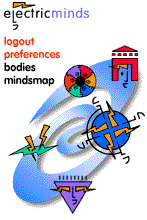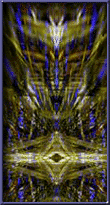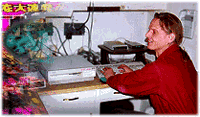
|

|
|
austin - jon lebkowsky
going native in cyberspace
The Net's full of art now, entire galleries full of stuff. If this is a new medium, then the question arises as to how much of that art is really "native" to the medium -- native to cyberspace. Look around, everywhere you find computer jockeys trying to do art and artists trying to grok computers, but how often do you find an artist who's also a quintessential computer geek? That's Bob Anderson, a cyberarts pioneer, a dedicated artist who for the past seven years has been responsible for a gonzo mass of individual and collaborative work conceived and realized in cyberspace. The story starts in 1988 when Bob Anderson (a.k.a. Bazooka), a surfer from Southern California came to teach drawing at University of Texas, Austin. A year later, he bought his first computer, an Amiga. Bob got on the Amiga-based BBS Alliance; he befriended the sysop, Bart, and a user known as the Mentor -- Lloyd Blankenship, who was working at Steve Jackson Games.
With Lloyd's and Bart's help, Bazooka started Pair O Dice BBS. He also discovered the net and the web. On a newsgroup called alt.artcom, Bob found a suggestion from artist Ed Stastny about creating a place online where artists could store their work, and so achieve "digital immortality." They got together. This was the beginning of OTIS (now SITO)
|
jzitt said: One thing I liked about living in (of all places) Brooklyn, was that I could walk to anything I needed to get to. For that matter, I've lived over the years in two places in Austin where I didn't need a car except for getting to work: Riverside Drive a few blocks from I-35 (back when Half-Price Books was still there) and at the Northcross Apartments, across from the Northcross Mall and the Village Theatre. The Northcross location was quite nice -- I was off a walkway far enough, but not too far, from the parking lot. I ate at Furr's at the mall a lot -- It was actually closer to my apartment than the college dining hall was when I was a student, and the food was of comparable quality, so I sort of considered it the commune eatery. :-) Most Active Topics: Topic 4 Slacker: Austin or Anytown? Topic 62 Conference Biz: Feedback and Discussion Topic 113 Country and Eastern Music | |||

 "The artwork is an excuse for the art. The social activity of cyberspace interests me more than using Photoshop to make whizbang pictures."
  Sometimes, you just can't beat cardboard. | ||||
Also in Austin: On a Rock and Roll Fire Truck vr in 3space - realspace, mindspace, cyberspace going native in cyberspace | ||||
|
|
|
electric minds |
virtual community center |
world wide jam |
edge tech |
tomorrow |
conversations
Any questions? We have answers.
©1996, 1997 electric minds, all rights reserved worldwide.
|

